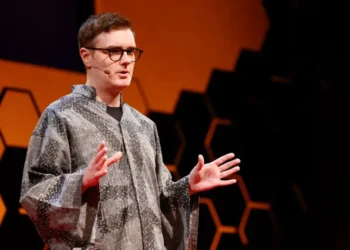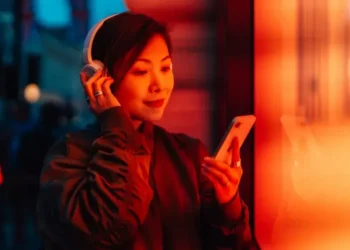Few people think twice about the barcodes on their shopping, but in the 75 years since they were first dreamed up, they have helped save lives, gone into space and stoked fears of the Antichrist.
Lasers. That’s what supermarket staff need, insisted Paul McEnroe. Scanners in the checkout and little pistol-shaped laser guns, too. Point, shoot, sell!
In 1969, it was an outlandish vision of the future: these lasers would scan weird little black-and-white markings on products that McEnroe and his colleagues at IBM had designed. It would speed up supermarket queues, he enthused. The solution would come to be known as the barcode.
At this point in history barcodes had never been used commercially – though the idea had been brewing for decades following a patent filed on 20 October 1949 by one of the engineers who was now part of McEnroe’s team. The IBM engineers were trying to bring barcodes to life. They had a vision of the future where shoppers whizzed through the checkout with lasers scanning every item they wanted to purchase. But IBM’s lawyers had a problem with the future.
“No way,” they said, according to McEnroe, a now-retired engineer. Their fear was “laser suicide”. What if people intentionally injured their eyes with the scanners and then sued IBM? What if supermarket staff went blind?
No, no, this was a mere half-milliwatt laser beam, McEnroe tried to explain. There was 12,000 times more energy in a 60-watt lightbulb. His pleas fell flat. And so he turned to Rhesus monkeys imported from Africa, though now he can’t remember how many. “I think it was six,” he says. “I couldn’t swear to that.” After tests at a nearby laboratory proved that exposure to the tiny laser did not harm the animals’ eyes, the lawyers relented.
And that is how the scanning of barcodes became commonplace in supermarkets across the US, and ultimately the entire world.
Barcodes have always upset some people. To a fanatical few, they are nothing short of evil
In an unexpected twist, the laboratory used by McEnroe subsequently told him it would be sending him the monkeys. They were his problem now. “It was crazy,” he recalls, laughing. “I found a zoo in North Carolina.”
Alongside the monkeys, each human member of McEnroe’s team at IBM also deserves credit for the Universal Product Code (UPC), as their version of the barcode became formally known. Among their number was Joe Woodland, the engineer who dreamed up the early concept behind barcodes decades earlier, after drawing lines in the sand on a beach. It was he and another engineer who made the application to patent the fundamental idea for barcodes back in October 1949.
Crucially, George Laurer and other members of the IBM team then took this pre-existing proposal for barcode-style markings and developed them into a neat rectangle of black, vertical lines corresponding to a number that could uniquely identify any supermarket item imaginable. From tins of soup to boxes of cereal or packets of spaghetti. The grocery industry formally adopted the UPC in 1973 and the first product bearing one was scanned at Marsh Supermarket in Ohio in 1974. From there, it conquered the planet.
At either end are “guide bars” that tell the scanner which direction it should read the code, meaning it can work even upside down.
Between these, the first six to 10 digits correspond to the company or brand owner, the following one to five are the item number and the last is a check digit formulated based on the previous 11 numbers.
Once the scanner has read the number, a computer uses it to look up the product in a database that will contain further information such as, crucially, its current price.
Other kinds of barcode soon followed and the UPC also laid the foundations for so-called “2D barcodes” such as QR codes, which can encode even more information. But the history of these little black-and-white markings is far wilder and rockier than you would ever imagine.
You could even argue that it began with the Central Intelligence Agency (CIA).
“I was scanning things for the CIA,” explains McEnroe. “Great big maps.” That was one of his first jobs at IBM, involving image scanners. As he explains in his book about the invention of the UPC barcode, this helped to prepare him for working on completely new, but related, technology that would revolutionise the retail industry.
McEnroe knew that checkout lines in stores would move much more quickly if staff could just scan products into a computer rather than having to read the prices stamped on each item and then manually process the sale. To be accepted, such a code-scanning system would have to work pretty much every time – and read the code correctly even if the product was pulled across the scanner at speeds of up to 100 inches per second (2.5m/s).
The IBM team set to work, drawing on the design patented by Woodland and his colleague – however, with an important difference. The original approach relied on reading the thickness of the black lines. One of the concepts they had proposed in the patent – a round, bulls-eye style barcode formed of concentric circles – had even been developed by a competing group. But this had proven difficult to print and even harder to fit neatly onto product packaging.
The IBM team worked out that it was easier to print vertical lines and base the scanning process not on measuring the thickness of those lines but rather the distance between the leading edge of one line and the leading edge of the line next to it. In other words, the space between the lines, which was more reflective and easier to pick up by the scanner. That way, it didn’t matter if the label printer had too much ink and drew lines that were thicker than intended – the scan would still work, pretty much every time.
While the first barcode-branded product was sold in a US supermarket in 1974, it took another five years for barcodes to reach British supermarkets. As soon as they did, the first item to be scanned there was a box of teabags.
McEnroe stresses that the launch of UPC barcode technology was not without controversy. “Our first store didn’t open,” he recalls. There were people outside protesting the fact that prices would no longer be stamped on every product, merely on the shelves where products were placed in-store.
Some labour unions at the time felt – ultimately, correctly – that scanning technology threatened certain supermarket jobs. There were also concerns that barcodes could be used to obfuscate prices. McEnroe himself remembers how, in the past, shoppers sometimes searched for aging items in a supermarket since those ones might still have an older, lower price stamped on them. If barcodes took over, opportunities for such bargain-hunting would disappear.
These worries soon fizzled out. But barcodes have always upset some people.
To a fanatical few, they are nothing short of evil. In 2023, Jordan Frith, a professor of communication at Clemson University in South Carolina, published a book about the history of barcodes. During his research, he found a 1975 article in a publication called Gospel Call that suggested barcodes could be “the Mark of the Beast” – a reference to a biblical prophecy from the Book of Revelation about the end of the world. The New Testament passage in question refers to a beast – sometimes interpreted as the Antichrist – that forces every person to be marked on their right hand or forehead. In the prophecy, only those who accept such a mark are allowed to buy or sell.
The 1975 article suggested that, eventually, barcodes would be “laser tattooed” onto everybody’s forehead or the back of their hand, ready for presentation at supermarket checkouts.
Although bizarre, the idea has proved surprisingly sticky. A 1982 book called The New Money System by evangelical writer Mary Stewart Relfe further popularised the supposed connection between UPC barcodes and the Mark of the Beast after she claimed the number 666 was “hidden” within the lines at either end and the middle of each barcode.
In fact, these “guard lines”, as they are known, serve as a reference point to help the laser scanner pick out the start and end of each UPC sequence. Laurer in the IBM team, considered co-inventor of the UPC, later insisted there was nothing sinister about this and the resemblance to the pattern used to encode the number six was a coincidence.
It’s kind of strange to imagine a bunch of grocery executives leading the way for the apocalypse – Jordan Frith
But the bizarre theory can still be found in certain corners of the Internet. And some even take extreme steps to avoid barcodes, including members of an orthodox Russian Christian group known as Old Believers. One such Old Believer, Agafia Lykov, who lives in an especially remote part of Siberia, told visiting journalists from Vice in 2013 that barcodes were “the stamp of the Antichrist”. She added that if anyone gives her something, such as a packet of seeds, with a barcode on it, she takes the contents out and burns the packet.
Plus, in 2014, a Russian dairy company posted a statement on its website explaining why there was a red cross printed over the barcodes on its cartons of milk. Because, as is “well known”, the statement read, barcodes are the Mark of the Beast. The statement has since been removed from the company’s website.
McEnroe says he is aware of some of these strange beliefs around barcodes. “It’s not something I would be prone to think,” he says, rather diplomatically. Frith makes another point: “It’s kind of strange to imagine a bunch of grocery executives leading the way for the apocalypse.”
And yet there is, arguably, something strangely dystopian about barcodes. For some, they have become symbols of capitalism in its coldest form. They also often turn up in chilling sequences in movies. In The Terminator, we learn that prisoners of killer robots in an apocalyptic future receive barcode markings on their arms for identification. “This is burned in by laser scan,” time-travelling protagonist Kyle Reese explains to a terrified Sarah Connor. “Some of us were kept alive to work – loading bodies.” The barcode marking, in this context, has echoes of the numbers tattooed on the arms of Nazi concentration camp prisoners during the Second World War.
Sometimes people do use barcodes malevolently. Especially when it comes to QR codes, which rather than using vertical lines consist of constellations of tiny black and white squares in a pattern that is readable by digital smartphone cameras.
Because scanning a QR code with your phone can direct your device to a malicious website, for example, QR codes have occasionally been deployed by hackers. The UK’s National Cyber Security Centre has warned members of the public to be wary about QR codes. Drivers in several English towns have also been warned about a scam where fake QR codes were stuck to car parking machines in an attempt to steal money from unwitting motorists. One code used in car parks in Leicester was even linked to Russia.
And, in September, Lebanon-based armed group Hezbollah accused Israel of dropping leaflets containing a dangerous barcode, referred to in some reports as a QR code, that could “withdraw all information” from any device used to scan it. The BBC has not been able to verify these claims.
Despite some nefarious uses of barcodes, and outlandish claims that they represent the Mark of the Beast, these markings now underpin thousands of industrial and commercial processes all over the world. An estimated 10 billion barcodes are scanned globally, every day, according to GS1, the organisation that oversees UPC and QR code standards.
You might have noticed the barcodes and QR codes on the packaging of items you receive in the post, for example. A single packet can be scanned many times on its journey from warehouse to you, says Frith. And because barcodes allow retailers to keep track of huge product inventories, that means these businesses can operate giant stores with relatively few staff. “You wouldn’t have these superstores or anything like that without barcodes,” says Frith. “It’s changed the physical shape of retail.”
Erin Temmen, an account manager at labelling firm Electronic Imaging Materials, agrees with this assessment. Her company, like some others in the industry, produce barcode labels that will work in practically any environment. This includes cold-resistant labels that won’t fall off equipment filled with liquid nitrogen, for example. And chemical-resistant labels that will retain their barcode even if they get splashed with nasty substances in a laboratory. The firm also produces extra reflective barcode labels. “That increases the scan distance,” says Temmen. It makes it easier for hurried workers to scan the code at a distance of up to 45ft (14m), making it detectable even if the barcode is on an item placed high on a shelf, for example.
Such versatility hints at the wide variety of contexts in which barcodes are actually used. They have helped to track the behaviour and movement of honeybees and songbirds, tagged eggs and embryos in fertility clinics to avoid mix-ups, and been placed on gravestones to direct visitors to online memorials for the deceased.
The US military also uses barcodes to help it track the attendance and training of personnel. One University in Saudi Arabia also piloted using barcodes to record student attendance at lectures.
Barcodes have even made it into space. Astronauts on the International Space Station use barcode scanners to identify equipment and mechanical parts, although they have largely been replaced with radio frequency (RFID) tags now. Barcodes are also employed to log the food and beverage intake by astronauts, as well as to identify their blood, saliva and urine samples.
Back on Earth, it’s possible that barcodes have saved lives. Hospitals use barcoding systems to track blood samples, drugs and medical devices such as hip replacements. The UK’s National Health Service (NHS) has a Scan4Safety programme, to promote the use of barcodes for tracking such things. Machine-assisted identification can help staff ensure clinicians administer the correct drug to the correct patient, for example.
According to a report on Scan4Safety, the introduction of this technology has freed up 140,000 hours of staff time for patient care that would otherwise have been spent performing administrative tasks and inventory checks. It claims barcode scanning has also saved the health service millions of pounds.
“I speak with clinicians and members of staff in hospitals responsible for managing inventory – they all report benefits,” says Valentina Lichtner, a senior lecturer of digital health and decision making at Leeds University Business School. She is currently researching the impact of barcode tracking systems in healthcare settings.
None of this would have been possible without Woodland’s lines in the sand
And in a world where barcodes are pretty much everywhere, it’s possible to design interesting games and experiences around them. One of the most inventive examples was Skannerz, an early 2000s handheld video game that had an integrated a barcode scanner into the device. Players were required to scan random barcodes on groceries, for example, until they found a code that happened to trigger the “capture” of an alien monster in the game – something that has strong echoes of the Pokemon games. Other games – including Japan’s Barcode Battler – have also relied on getting players to scan barcodes as part of the “fun”.
None of this would have been possible without Woodland’s lines in the sand and the work of McEnroe and his team at IBM. Currently, there is a push – called Sunrise 2027 – to get retailers to adopt QR-style codes, over the older, vertical line-based designs. This would allow them to encode more information – such as use-by-dates on food packaging or instructions for how to use a certain cleaning product. But Frith says he thinks the traditional barcode will likely stick around for a long time to come. It is a deceptively simple technology that has, he says, impacted countless industries.
And yet, despite being everywhere, most people wouldn’t give barcodes a second thought. “The biggest testament to their success,” says Frith, “is that we never think about them.”
Source
This article was rewritten by JournosNews.com based on verified reporting from trusted sources. The content has been independently reviewed, fact-checked, and edited for accuracy, neutrality, tone, and global readability in accordance with Google News and AdSense standards.
All opinions, quotes, or statements from contributors, experts, or sourced organizations do not necessarily reflect the views of JournosNews.com. JournosNews.com maintains full editorial independence from any external funders, sponsors, or organizations.
Stay informed with JournosNews.com — your trusted source for verified global reporting and in-depth analysis. Follow us on Google News, BlueSky, and X for real-time updates.














